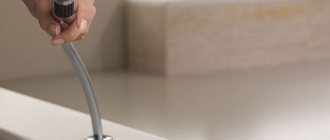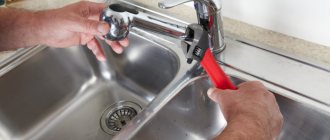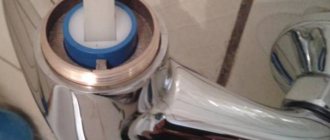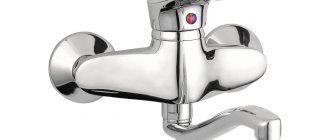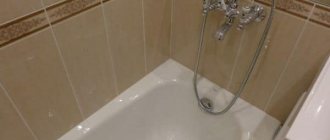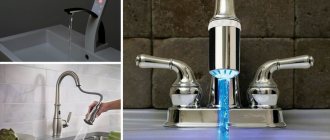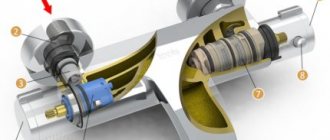The most common symptoms of malfunction and methods of elimination
To avoid unnecessary repairs or replacement of the faucet, you should ensure that there are no flaws in the cleaning system.
| Defect sign | Probable cause, solution |
| The water is white. | The cleaning system is contaminated. After some time the air will go away. |
| A sharp decrease in pressure. | The filter (membrane) is clogged. Replacement or regeneration. |
| A sharp increase in pressure. | The filter (membrane) is damaged. Replacement. |
| Undermining in a closed state. | Defect in the shut-off device. Repair or replacement. |
| Complete lack of water pressure when there is water in the system and the tap is open. | Problems with the cleaning system. Repair. |
The splines on the flywheel or on the axle box are worn out. Replacing the flywheel or axle box.
The most popular are inexpensive single-lever samples that are easy to repair. However, their failure often raises questions and is therefore worth considering.
How to eliminate a leak in a pipe at a threaded connection
In cases where leaks occur at the joints of pipes connected by threads, it is worth using FUM tape or linen thread with a special waterproof impregnation. Initially, you should remove the old seal from the thread. Currently, FUM tape is produced in the following types: FUM-1 - with vaseline-based lubricant. Used in industrial piping systems. FUM-2 – contains no lubricant; Can be used for acidic environments FUM-3 – used for pipes without aggressive media
How to fix it yourself?
According to the method of adjusting the water pressure, taps are divided into rotary and lever products.
Lever models come in two types:
- based on a metal ball;
- based on a cartridge with a ceramic mechanism.
The principle of operation and design of different cranes is different, therefore disassembly is carried out differently.
Dismantling the entire product is required in rare cases, but the removed faucet is easier to inspect and disassemble.
To do this you need:
- Prepare: a flip screwdriver, pliers, straight and lever adjustable wrenches, a container for water.
- Close the cold water supply valves to the system and to the storage tank.
- Unscrew the nut that secures the supply tube and disconnect the tube.
- Unscrew the clamping nut of the faucet shank.
- The tap has been removed.
If the nuts have become stuck, they are treated with WD40 or an analogue, leaving them to “sour” for 10-15 minutes.
How to seal a leak in a pipe: chemical methods (sealants)
The use of chemical methods for eliminating leaks uses various chemical compositions. Most often silicone based. Their use is due to high heat resistance (up to 350 degrees) and increased wear resistance. Fiberglass painting cloth is usually used as a reinforcing element.
The damage repair steps are as follows:
- A 2-3 mm thick sealant is applied to the cleaned damaged surface of the pipe, over which a painting cloth is rolled (back to back, layer to layer)
- On top of the first layer, another layer of sealant is applied and then reinforcing fabric, but with an overlap of 5 mm turns.
- The total number of layers must be at least 4
- The fabric is laid tightly, without “air” layers.
- The last layer of sealant is applied
- The treated section of the pipe must be left to dry. Depending on the type of sealant, this can take from several hours to several days.
Seal a hole in a metal or polymer pipe
In case of very minor damage to a straight section of a pipe, a bend or a threaded connection, you can use ordinary superglue (eg: “Minute”) and soda. When using this method, the main thing is to properly prepare the damaged area for applying the adhesive. The surface must be completely cleaned and degreased. To do this, use a file (or grinder) and any solvent.
- At least 3 layers of molar tissue are applied alternately to the damaged area, with a layer of baking soda applied to each layer. The last layer will be a layer of glue, which reacts with soda to form a dense waterproof shell.
- If the damage is a crack, then soda is driven inside and glue is applied on top. The chemical reaction will create a dense shell.
Features of repair if it leaks and drips
If a sign of breakdown is water dripping in closed mode, it is not necessary to remove the product from the sink.
Having closed the valve, you should disassemble the faucet and remove the locking mechanism.
In rotary models, this mechanism is a crane axle box. Its action is based on the tight pressing of the elements of a ceramic pair.
Removing the axle box
- Almost all faucet handwheels (handles) have a plastic plug that covers the mounting screw. It can be simply inserted or screwed into a thread. In the first case, it is pryed off with a knife or screwdriver, in the second, it is unscrewed. If the plug is missing, then the flywheel should simply be removed with some effort. In order not to spoil the appearance of the product, a piece of leather or thin plastic is placed under the lips of the instrument.
- Then you need to unscrew the screw that secures the handle. If it has become stuck (rusted), it is treated with WD40 or Unisma. When this does not help, it is drilled out or the entire tap is replaced.
- After removing the flywheel, unscrew the decorative cap of the valve axle box. Usually it comes “by hand”. If it doesn’t work, then a lever adjustable wrench with spacers between the lips will help.
- Under the cap there is a valve axle box. It can be unscrewed with a straight adjustable wrench without unnecessary effort.
We invite you to watch the video instructions with a detailed description of dismantling the device:
- made of brass body;
- rotary rod with seals;
- I-beam rubber gasket;
- ceramic pair.
The defect, as a rule, consists in the wear of ceramic elements or the formation of plaque on them. Sometimes the cause of the problem is wear (drying out) of the sealing gasket.
It may be difficult to find exactly the same axle box crane, since there are quite a lot of their modifications. It's worth purchasing at least a repair kit.
It usually includes:
- rod seals;
- ceramic pair;
- sealing rubber.
Axlebox repair
- Disassembly begins with removing the U-shaped retaining ring inserted into the recess on the rod. It can be easily removed using a thin flathead screwdriver.
- Then the sealing gasket, which is not fixed in any way, is removed.
- Underneath it are ceramic elements that lie freely on the base of the stem. They should simply fall out of the case.
Is it possible to repair a crack in a faucet?
Just yesterday something bad happened: a small crack appeared on the faucet in the bathroom.
Is there any way I can repair it or should I run to the store for a new one? If a crack appears, it means the mixer is made of a low-quality alloy, such as silumin (this is silicon with aluminum).
Typically, such mixers are not durable; silumin loses its properties after just a couple of months of use, it becomes fragile.
You forgot to write in which place (where) the crack appeared (for example, if this is the “spout” of the mixer, then they are sold separately).
If this is a straight section, then you can install a clamp with a gasket; even silicone will help temporarily.
Another option is to caulk the crack. Take a hammer and something blunt, like the back of a chisel, or better yet, a punch.
Use light blows on both sides of the crack, trying to cover the gap, as it were, sometimes this helps.
All methods described are temporary solutions to the problem.
The mixer is under pressure and sooner or later the crack will begin to grow.
Do not buy inexpensive faucets, especially those made of silumin.
When choosing a mixer, pay attention to its weight; silumin weighs almost nothing, but a high-quality mixer is heavy.
First of all, of course, I will give advice not to buy cheap faucets made in China.
And this is not because they have a short service life, and they have to be repaired and replaced, but because the apartment and especially the neighbors may flood.
So it’s better to buy and install a high-quality mixer.
But there are times when repairs are necessary and it is not possible to quickly purchase a new high-quality faucet.
That’s when it’s tedious to make a decision quickly and repair it.
This is what a Chinese-made silumin mixer looks like with a crack formed.
Let me explain what silumin is, otherwise they explain it on the Internet and it seems that they got no more than a C in chemistry at school.
So silumin is an alloy of aluminum and silicon, and the name contains the base from silicium, namely silicon in Latin and alumin (short for aluminum).
In this case, the crack is highlighted in blue.
Of course, repairs will not give you a full guarantee that the mixer will work for a long time and reliably. But after disassembling it and cleaning and degreasing the crack, you can seal it with cold welding. Naturally, you apply the welding from the inside and can do it in several layers.
But I warn you that it is better to lower the water pressure in the line to the mixer and not make sudden temperature changes from cold to hot.
So in such conditions, you can use the mixer until you purchase a new and high-quality one.
Even in high-quality brass faucets, cracks sometimes appear - this is the result of a factory defect (poor casting). Such a crack needs to be hammered out, treated with acid, the mixer heated and soldered (you can even use tin) using a gas torch.
If you come across a cheap Chinese faucet, you can try to repair the crack with epoxy.
At one time, for use in apartments during renovations, I revived such a mixer with epoxy glue and fiberglass.
- The mixer needs to be completely disassembled - remove all the insides (cartridge, gaskets, seals.).
- Carefully (as far as possible) deepen and widen the crack; this can be done with a small grinder with a thin disk. Do not knock on the mixer, otherwise it may collapse.
- clean the crack and rinse with solvent.
- We heat the mixer in an accessible way (gas, electric stove.) so that the gap widens as much as possible.
- In parallel with heating the mixer, heat the prepared epoxy glue in a steam bath. Hot resin becomes liquid and fills narrow crevices well. The viability of the glue decreases significantly, so you need to work quickly.
- tightly stuff a cloth soaked in oil inside (you can use Vaseline). We do this so that the epoxy does not get inside through the gap.
- Fill the gap with epoxy.
- the next day (the glue has hardened), cut out a strip of fiberglass of a suitable size, soak it in freshly prepared epoxy and wrap the strip around the problem area at least 2 times.
- on the third day (if desired), mix the epoxy and use a brush to carefully cover all the unevenness on the fiberglass. After the glue has hardened, we process the repair area with a file.
- degrease the entire mixer and paint it with silver from a spray can.
An ignorant person will not be able to tell at first glance that the faucet is “glued.”
My mixer “traveled” around apartments for more than a year, and then someone “attached legs” to it (apparently they didn’t notice the catch).
How to disassemble a broken faucet for drinking water filter
A great idea is to install a drinking water filter with a separate tap in the kitchen. This solution will allow you to use purified water exclusively for drinking and cooking.
However, during long-term operation, you may encounter a problem - the faucet begins to drip and leak, and sometimes stops working altogether. Why is this happening?
- Firstly, a crane is, albeit the simplest, a mechanism whose parts have their own resource.
- Secondly, untimely replacement of filter cartridges negatively affects the quality of water; hardness salts remain in it, which form limescale, which negatively affects the operation of all plumbing fixtures.
If you have a leaking faucet for a drinking water filter from Aquaphor, Geyser or another manufacturer, these instructions will help you fix the problem yourself and at minimal cost.
Note! Timely replacement of filter elements not only ensures high quality water purification from alkaline earth metal salts and other unwanted impurities, but also extends the service life of the drinking water filter faucet.
Follow the manufacturer's recommendations - change cartridges regularly. Otherwise, the filter tap may need to be replaced !
How to repair a leak in a pipe: emergency methods without shutting off the water supply
During the operation of systems containing pipelines, leaks often occur. Such malfunctions can occur as a result of careless handling, improper installation, or simply due to wear and tear of the material. Moreover, a leak can occur in pipes made of both metal and plastic-containing substances (plastic, metal-plastic, polypropylene, etc.)
The following troubleshooting methods are available:
- Mechanical
- Chemical
- Combined.
The first type is associated with the use of improvised means. Self-tapping screws, harnesses, clamps and more can act in this capacity.
With the chemical method, the malfunction is eliminated using adhesive and astringent chemicals, such as silicone or other sealant.
The latter method involves the use of mechanical means and chemicals.
Regardless of which method will be used, it is necessary to decide “whether it is necessary to shut off the entire water supply system, only a separate part of it, or whether shutting off is not required at all.”
In case of small diameter holes (up to 2-3 mm), shutting down the system is not necessary. If holes of a larger diameter appear, in order to avoid emergency situations, it is better to shut off the network above the leakage point (along the direction of movement of the liquid in the pipe).
Repairing a water filter tap - step-by-step instructions
Drinking water taps produced by different manufacturers vary in design, shape and size, but they all have a similar design and work on the same principle.
The main elements of any crane are:
- spout (gander);
- crane axle housing;
- valve box (valve head);
- rotary lever or valve;
- decorative cap;
- water supply tube from the cold water system (rod).
In most cases, the cause of filtered water faucet leaks is wear of the faucet axle, the formation of limescale on the ceramic plates of the valve head and abrasion of the rubber gaskets.
All these troubles can be eliminated without the help of a specialist, having at hand a flat-head screwdriver and a 14mm wrench (less often 15mm). If there are no keys, ordinary pliers will help out.
To find out the cause of the problem, you need to dismantle and disassemble the tap.
Remove the faucet from the sink in the following sequence:
- Turn off the water;
- Disconnect the water supply tube;
- We remove the tap from the installation hole by unscrewing the fastening nut of the water supply tube;
- Remove the rotary lever (as a rule, it simply unscrews);
- We take out the decorative plug;
- We unscrew the valve axle itself with a wrench or using pliers.
VIDEO INSTRUCTIONS » alt=»»> The faucet box for the Aquaphor, Geyser or Barrier filter mixer is a small device that performs the function of opening and shutting off the flow of water.
The main working elements of the crane axlebox are two ceramic (less often plastic) plates.
When you turn the faucet lever, the plates move, opening and closing the hole for the passage of water.
If the filter element is not replaced in a timely manner, a lime film forms inside the faucet box and on the ceramic plates, which breaks the tightness of the device.
To clean the faucet box from limescale, you need to:
- Remove the rubber seal;
- Using a flat-head screwdriver, remove two ceramic plates from the housing;
- For 2-3 hours, soak the metal body of the faucet axlebox and plates in a warm solution of water with citric acid;
- Rinse the parts in running water and wipe dry with a clean cloth or napkin.
Assembling the valve box and installing the filter valve in place is done in the reverse order.
VIDEO REVIEW » alt=»»>
It would not be superfluous to soak the chrome parts of the faucet - the gander and decorative elements - in a solution of citric acid.
This procedure will remove the white coating and give the product its original appearance.
In most cases, the problem of a dripping filter faucet can be solved by disassembling and cleaning the faucet box, as well as by replacing worn gaskets and seals.
If these manipulations do not produce results, this means that the life of the crane axlebox has been exhausted and it is necessary to replace it. It will also be much cheaper than buying the entire filter faucet assembly.
Source
How to repair a leak in a pipe: mechanical methods
There are various methods using available materials to close the damage in the pipe.
Seal a leak in a metal pipe using a self-tapping screw.
In the event that on a metal pipe with a wall thickness of more than 3 mm. a small “drip” type hole with a diameter of up to 3 mm was formed. You can use a regular self-tapping screw with a rubber washer:
- The surface around the damage should be cleaned of rust deposits using a file.
- Then a self-tapping screw with a rubber washer is screwed into the hole, ensuring that the protruding part of the self-tapping screw inside the pipe is minimal. To carry out the work, it is better to use a screwdriver or electric drill.
In order to avoid damage to the tool, you should use a screwdriver with a built-in battery, wrapped in polyethylene.
Seal a leak with a diameter of more than 3 mm in a metal pipe.
If such a problem occurs, the danger of an emergency situation increases and most likely a screwed-in screw will help, but not for a long time, but you can try screwing several screws into one hole. In this situation, it is better to use a bolt, having first made a thread for it in the resulting hole. As in the previous case, there should be a rubberized washer on the bolt, and its protrusion above the inner surface of the pipe is minimal.
Seal a leak in a pipe made of metal or polymers using a rubberized metal clamp.
If small diameter damage occurs, you can use a regular metal clamp.
The clamp is selected to match the diameter of the damaged pipe.
There must be a rubber gasket on the clamp. If it is not available, it can be made from an ordinary piece of any rubberized fabric with a thickness of at least 3 mm.
In a situation where there are several leaks located close to each other on a straight section of the pipe, it is more effective to use a wide clamp.
How to seal a leak in a metal pipe or battery using a magnet.
This method is suitable for small diameter damage (about 1 mm) on a metal pipe:
- The surface around the damage is cleaned with a file or grinder.
- A small magnet is applied to the hole
The essence of the method lies in the ability of a magnet to attract metal particles contained in a liquid flowing through a pipeline. These can be various impurities, sediments and other suspended metal particles. During the action of the magnet, a “plug” appears, plugging the resulting damage.
Low water pressure in the apartment: where to go? sequencing
Replacing the water supply system in an apartment with plastic pipes, overhauling and replacing faucets and valves as necessary, cleaning or replacing flexible hoses can significantly increase the water pressure in the apartment. You should also pay attention to coarse filtration meshes. They can be cleaned or replaced as needed.
We suggest you read How to descale anything
Interesting: Why do people get divorced after 25 years of marriage?
If within a month the company has not taken effective measures (which it must report to the applicant in writing or orally), it must contact the control authorities. As a rule, this role is played by the city administration’s housing and communal services department.
Cleaning metal-plastic sewer pipes
Cleaning a metal-plastic pipe is much easier than cleaning a steel pipe. If there are a large number of identical components, number the parts and write the name of the fastener if necessary.
Clean the metal-plastic water supply using a flexible string from any side convenient for you. Make the most of fittings that can be removed to reach all parts.
Contaminants in metal-plastic pipes form mainly on bends and turns. Dirt generally does not linger on the walls.
It is best to clean such pipes using saline or alkaline chemicals that can destroy contaminants without causing any harm to the plastic.
A little bit of science
First, let's study a little what a chrome surface is. In our minds we are always talking about a shiny and mirror structure. Visually everything is correct, but from the point of view of galvanoplasty everything is much more complicated. Chromium itself is not used in its pure form; in the process of applying it to the surface of products, its compounds (solutions) are used. Moreover, chrome plating is carried out on the so-called sublayer, which can be a thin film of copper or nickel. Thus, the resistance of such a surface to destruction is significantly increased. The components of almost all high-quality faucets are presented as follows: the base is brass, the sublayer is nickel and the top is chrome.
On cheap products made from silumin, galvanic application of chromium is difficult to implement, so special varnishes are widely used. This product has nothing in common with real chrome plating, which can be distinguished by its cool blue tint.
In general, when choosing a faucet for a bathroom or kitchen, focus on the weight of the device and the shade of its surface.
How to clear blockages
In the modern world, there are many different methods that help not only get rid of blockages, but also take preventive measures in order to avoid unpleasant situations.
All chemicals that help deal with clogged sewer pipes are alkaline and acidic. Mixing them at the same time is under no circumstances acceptable.
There are a large number of different means, but the principle of operation is the same. It is necessary to pour the chemical into the sewer hole and add a small amount of water.
Then you should wait about half an hour and add plenty of hot water.
Anti-clog remedies
- Volley discharge of water. Close the drain and fill the bathtub with plenty of warm water. After this, open the hole and a large stream of water will help get rid of the resulting blockage.
- When asked how to clean bathroom pipes, the answer is simple - soda and bleach have proven themselves to be the best. To clean, pour these substances into the bathroom and fill with vinegar. After a huge amount of foam has formed, turn on the hot water and thoroughly rinse the entire system.
- Caustic is the main element contained in special preparations intended for cleaning sewer pipes.
All chemicals should be used according to instructions.
The peculiarity of all of the above remedies is that they help to effectively deal with blockages that have just formed. For old contaminants, more effective methods must be used.
Methods for cleaning a nickel-plated or chrome-plated faucet
Such surfaces require careful care. They need to be thoroughly cleaned and disinfected. You can clean the faucet using the following products:
Dishwashing liquid. Take 1 glass of warm water and mix 1 tablespoon in it. detergent
Then take a sponge soaked in the prepared solution and carefully clean all parts of the structure
Please note: the spout, base, levers and valves of the faucet should be thoroughly cleaned.
Baking soda. To clean rust from a chrome bathroom faucet, you will need baking soda. Take a soft sponge and lightly dampen it with water, you can also use a cloth. Using them, spread the baking soda over the surface and leave it for 30 minutes. After this, the soda can be washed off with cool water.
White vinegar. Pour white vinegar (6%) into the spray bottle and spread it over the surface of the product; mineral deposits will begin to dissolve. Leave the vinegar drops on for 10 minutes. Then the mixer should be wiped with a dry cloth.
There is low water pressure in the apartment - what to do and where to go
As experts note, most often, clogged pipes and a decrease in water pressure occur due to rusted joints of plastic and metal pipes. Fortunately, the problem is easily solved.
The main thing is to have the necessary finances and time. To restore pressure, it is necessary to clean the pipes.
If this procedure turns out to be useless, then it is recommended to completely replace the metal pipes with plastic ones.
- If there is a problem with the mixer, you need to replace it. If you don’t have the money to buy a new one, you can try to wash it or repair a broken part;
- If the pressure is poor due to a clogged aerator, then you also need to clean it with a needle and blow out. If the aerator is very clogged, then it is easier to buy a new one and install it on the tap.
- If you need to change pipes, then only specialists will help. The owner is only required to purchase the necessary materials. It is worth noting once again that it is better to change the riser completely, otherwise due to the joints the pressure will weaken again soon.
- A pump that increases the pressure in the apartment or on the riser will also help solve the problem. Installing a pump on the riser is necessary only when complaints to the housing office are unsuccessful. A sump pump is expensive, so you need to work with your neighbors to purchase it.
- If the diagram is incorrect, you need to change the sequence of connecting the devices to the water supply. Only a specialist will help in this matter.
Initially insufficient pressure level
According to GOST, the pressure level of the water supply network in the city should be 4 atmospheres.
In practice, it can fluctuate in the range of 3-5 atmospheres.
In megacities, the required pressure is regulated by electrical devices and is almost always normal.
It will be interesting: The only method to properly disassemble a shower head
This problem can be corrected by contacting public utilities that are assigned to certain territories. You should first find out about the water pressure from your neighbors, especially from the upper floors.
Is it possible to avoid plaque formation?
It is impossible to avoid the appearance of plaque inside the faucet. Although in different regions of our country water has different hardness, it still contains a certain amount of magnesium and potassium salts, which form plaque.
But it is quite possible to restore external beauty and shine if you make it a rule to wipe the faucet after use. A napkin or the soft side of a sponge is suitable for this purpose.
Tap water always contains minerals. In some regions there are more of them in the water, in others there is much less, but they are definitely there. Not only the hardness of the water, but also the condition of your faucet depends on their quantity. It is because of mineral salts that whitish spots of dull limescale appear on the shiny surface of a chrome faucet. No self-respecting housewife will leave this disgrace unattended. How to clean a bathroom faucet without damaging its surface?
Bathroom mixer with shower if the pressure is low
How to turn on an overhead shower with a Grohe mixer? I don't know if you even sent a photo of it or not. On modern showers, the “switch” for the shower is either a lever or a special “piggy” that needs to be pulled up or towards you, it all depends on its location, otherwise when the water pressure is on.
The faucet in the shower has low pressure. it says “economical water consumption”.
in fact, what could be the reason? In theory: to save water (with the same pressure into the mixer), the watering can should have smaller holes to prevent water from leaving it and create the illusion of greater pressure.
If water flows weakly from it, then apparently there are too many holes in it. Usually this. Chinese? Are the valves screw-type or do they open in one movement, in the sense of a slight turn?
Natural remedies
Unfortunately, allergies are becoming one of the most common diseases in the world. Often allergic reactions are caused by household chemicals. In such cases, you can try to clean the faucet and taps in the bathroom using simple natural methods.
- Baking soda.
Dip a slightly damp washcloth in baking soda and wipe the surface with it. Rinse with water. - Soap solution.
Dissolve laundry soap in hot water. The resulting thick solution removes limescale well. If you add a spoonful of soda to the soap solution, the effectiveness will increase. - Lemon acid.
You can take crystalline citric acid, but it is better to clean the mixer with half a lemon. Dipping the lemon cut into fine salt will make the process even easier. Citric acid must be washed off well. - A weak solution of vinegar, table or apple cider vinegar.
Prepare a solution by diluting 9% table vinegar by half. Dampen a soft cloth or brush in it and clean your bathroom and kitchen faucets. Rinse with water.
In hard-to-reach places, taps can be cleaned with a soft toothbrush. Great for cleaning chrome surfaces in the bathroom, a special microfiber cloth.



